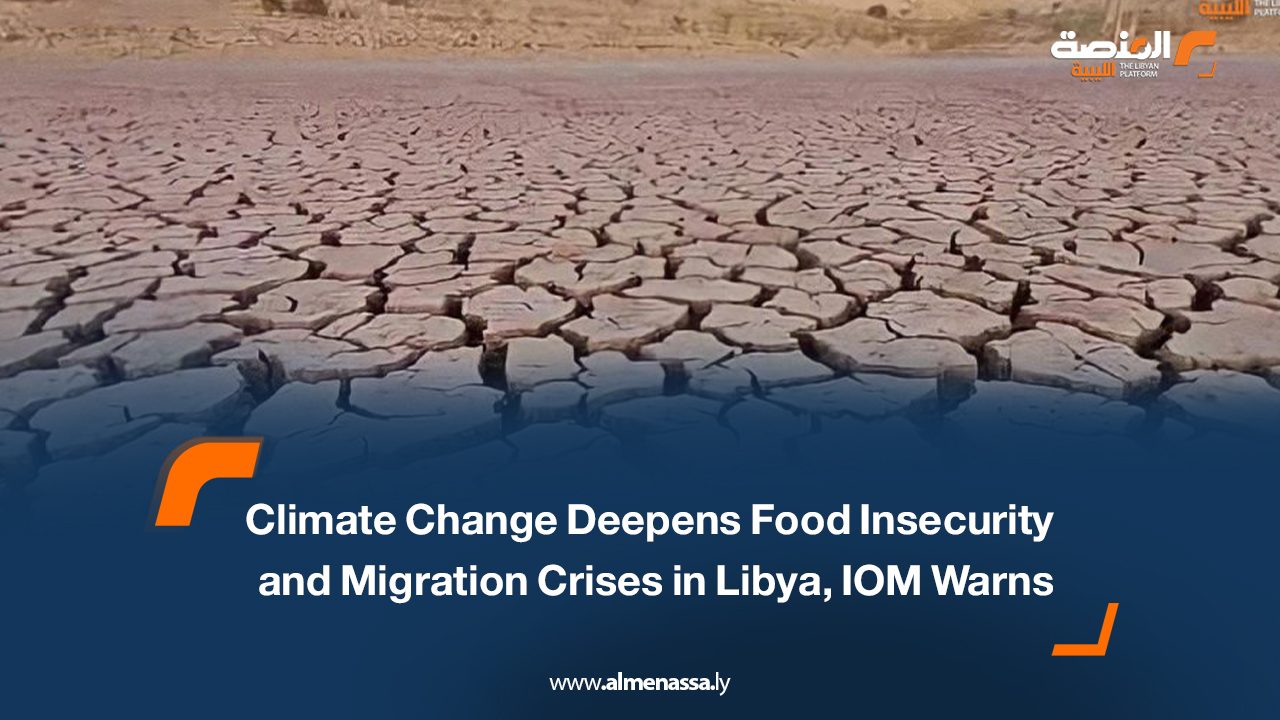A new report by the International Organization for Migration (IOM), supported by the European Union, reveals the mounting challenges Libya faces as climate change intensifies pressures on food security and migration. Titled “Climate Change, Food Security and Migration in Libya,” the study offers a comprehensive look at how environmental and economic instability are reshaping the lives of migrants across the country.
Libya’s Migrant Demographics
According to IOM data from the second half of 2024, Libya hosts over 787,000 migrants. The overwhelming majority 98% are male, with an average age of 27. Migrant communities are concentrated in three key regions: Jabal al-Akhdar, Jufra, and Misrata, alongside significant numbers in Tripoli and its surroundings.
The most represented nationalities include Sudanese (26%), Nigeriens (24%), Egyptians (21%), Chadians (10%), and Nigerians (4%).
Living Conditions and Food Access
The report highlights alarming levels of food insecurity among migrants. Only 42% of adults and 20% of children regularly receive three meals a day. Economic hardship has led 28% to suffer from poor dietary diversity.
To cope, migrants resort to difficult strategies:
– Consuming lower-quality or cheaper food (58%)
– Reducing meal size or frequency (45%)
– Borrowing money or seeking help from relatives (45%)
These indicators reflect growing vulnerability, driven by economic strain, climate disruption, and regional instability.
Migration Drivers and Destinations
While 66% of migrants intend to settle permanently in Libya, 18% hope to return home, and a smaller group aims to reach Europe—primarily Italy (35%), followed by the UK and France.
Economic factors remain the dominant force behind migration. Before leaving their countries, 51% were employed, 33% unemployed, and 12% self-employed. Most came from agricultural and pastoral backgrounds (66%), with others working in construction (20%) and trade or services (8%).
Climate crises—such as drought and desertification in Niger, Chad, and Sudan—were major push factors, alongside armed conflict and poverty.
Employment Realities in Libya
Once in Libya, 91% of migrants find employment as wage workers, while only 9% work independently. Job acquisition varies:
– 20% found work within a week
– 32% within a month
– 22% within three months
However, the work environment is fraught with risks:
– Delayed or unpaid wages (33%)
– Lack of job security (31%)
– Verbal abuse (23%)
A staggering 91% of workers lack formal contracts, leaving them vulnerable to exploitation and mistreatment.
Climate Change as a Threat
Libya’s climate challenges include rising temperatures, recurring droughts, and devastating floods—most notably the Derna disaster in 2023. Agricultural degradation and groundwater depletion are also accelerating.
Among migrants working in agriculture:
– 19% reported losses in crop yields or livestock due to climate shocks
– 9% were forced to shift sectors due to land deterioration
– 38% view climate change as a direct threat to their jobs
– 26% said it influenced the timing of their migration
Food Security Under Pressure
Libya’s heavy reliance on food imports makes it vulnerable to price volatility. Southern and remote regions suffer most due to poor infrastructure, high transport costs, and insecurity.
Internal displacement and urban migration are straining food distribution networks and public services, leading to rising malnutrition and supply shortages among both migrants and host communities.
Recommendations
The IOM calls for urgent, coordinated action to address these intersecting crises. Key recommendations include:
– Improving migrant access to food and economic integration
– Strengthening agricultural resilience through sustainable practices
– Stabilizing food markets and regulating prices
– Expanding regional cooperation in North Africa for climate adaptation
– Establishing early warning systems and shared data centers
– Investing in scientific research, AI, and big data for crisis forecasting
– Supporting local communities with disaster risk reduction programs rooted in traditional knowledge and localized vulnerability assessments
The report concludes that climate change is no longer merely an environmental issue—it is a humanitarian, economic, and security challenge. Migrants in Libya stand at the frontline of this crisis, facing a volatile mix of food poverty, climate risk, and precarious employment.
Without swift and comprehensive responses, Libya and the wider region may face an increasingly fragile future, where climate change and migration converge to form one of North Africa’s most pressing threats to stability.


